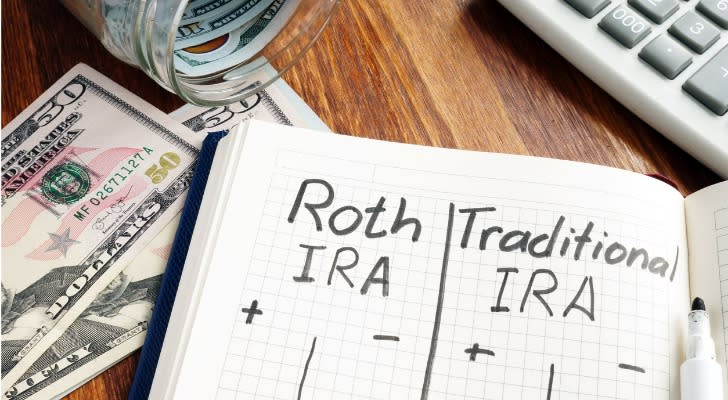Roth IRAs offer a tax-advantaged way to save for retirement, and they’re a popular choice among investors. However, understanding how Roth IRA contributions are taxed is crucial for making informed financial decisions. Let’s break down the marginal tax rate, compare Roth IRAs to traditional IRAs, delve into the taxation of Roth IRA contributions and examine whether Roth IRA withdrawals are ever taxed.
A financial advisor can help you set up and manage a Roth IRA. Match with a fiduciary advisor today.
Understanding Marginal Tax Rates
To comprehend how Roth IRA contributions are taxed, you must first understand the concept of marginal tax rates or tax brackets. Your marginal tax rate is the percentage of tax you pay on each additional dollar of income you earn. In the United States, the tax system is progressive, meaning that as your income increases, the percentage of tax you pay also increases.
Marginal tax rates are structured in a way that each portion of your income falls into a specific bracket, and each bracket has its own tax rate. For example, the first portion of your income may be taxed at a lower rate, while the portion that exceeds a certain threshold is taxed at a higher rate.
Marginal Tax Rates for 2023 | |||
Tax Rate | Single Filers | Married Filing Jointly | Heads of Households |
10% | ≤ $11,000 | ≤ $22,000 | ≤ $15,700 |
12% | > $11,000 | > $22,000 | > $15,700 |
22% | > $44,725 | > $89,450 | > $59,850 |
24% | > $95,375 | > $190,750 | > $95,350 |
32% | > $182,100 | > $364,200 | > $182,100 |
35% | > $231,250 | > $462,500 | > $231,250 |
37% | > $578,125 | > $693,750 | > $578,100 |
It’s crucial to know your marginal tax rate because Roth IRA contributions are made with after-tax dollars, meaning you’ve already paid income tax on the money you contribute. How much federal income tax you’ve paid on that money will depend on your tax bracket.
Roth IRA vs. Traditional IRA

Now, let’s compare Roth IRAs to traditional IRAs, which allow you to make tax-deductible contributions. This means you can reduce your taxable income for the year in which you make the contribution. However, when you withdraw funds from a traditional IRA in retirement, those withdrawals are subject to ordinary income tax.
This stands in contrast to Roth IRAs, where contributions are made with after-tax dollars and qualified withdrawals are tax-free.
However, not everyone can contribute to a Roth IRA. These accounts are subject to specific income limits. In 2023, single taxpayers and heads of households who earn more than $153,000 cannot make Roth IRA contributions. The same applies to married couples filing jointly who earn more than $228,000.
In 2024, the Roth income limits will increase to $161,000 for singles and heads of households and $240,000 for married couples filing jointly.
The choice between a Roth and a traditional IRA ultimately depends on both your current financial situation and your expectations for the future. If you project that your marginal tax rate will be higher in retirement than it is now, a Roth IRA may be the better option, as it allows you to lock in your current tax rate. However, if you anticipate a lower tax rate in retirement, a traditional IRA might provide more immediate tax benefits.
How Roth IRA Contributions Are Taxed

Since Roth IRA contributions are made with after-tax dollars, the money you put into your account will have been taxed at your marginal tax rate. However, in return for paying taxes up front, your savings grow tax-free within your account.
The tax benefits continue when you start taking withdrawals from your Roth IRA. While contributions may always be withdrawn tax-free, any money earned in the Roth IRA have to meet specific conditions for tax-free status. To enjoy completely tax-free withdrawals, your distributions must be “qualified.” To be considered qualified, your Roth IRA must have been open for at least five years, and you must be at least 59 ½ years old, permanently disabled or using the money for a first-time home purchase (up to a limit).
This is a significant advantage over traditional IRAs, where you would typically pay taxes on your earnings when you withdraw them in retirement. But unlike money contributed to a traditional IRA, Roth contributions do not lower your taxable income for the year.
Keep in mind that contributing more than the annual limit could trigger a 6% excess contribution penalty. For example, if you put $7,200 in a Roth IRA in 2023, you would have exceeded the IRS’s limit of $6,500 by $700. In that scenario, you would owe a 6% penalty on the excess money every year until it – and any earnings the money generates – are removed from your account.
Are Roth IRA Withdrawals Ever Taxed?
Generally, Roth IRA withdrawals are tax-free. However, there are some specific situations where you might encounter taxes or penalties.
Should you need to access your Roth IRA funds before reaching age 59 ½ or before the account has aged five years, you can generally withdraw your original contributions without incurring taxes or penalties. However, any earnings on those contributions that you withdraw may be subject to income tax and a 10% early withdrawal penalty. This penalty can be waived in certain situations, such as for first-time home purchases or qualified education expenses.
Bottom Line
Roth IRAs can be a valuable component of your retirement savings strategy, providing the potential for tax-free withdrawals in retirement. Understanding how Roth IRA contributions are taxed is essential for making the most of this retirement account. Your marginal tax rate plays a crucial role in this, and you should consider your current and future tax situation when choosing between a Roth and a Traditional IRA. Additionally, it’s important to be aware of the rules and restrictions to ensure you don’t incur unexpected taxes or penalties when making withdrawals.
Retirement Planning Tips
You don’t have to check your IRA or 401(k) balance every day, but it’s important to periodically track the progress you’re making toward your retirement goals. SmartAsset’s retirement calculator can help you get a sense of how much your savings could be worth in the future and how much you may need to support your lifestyle in retirement.
A financial advisor can help you plan and save for your golden years. Finding a financial advisor doesn’t have to be hard. SmartAsset’s free tool matches you with up to three vetted financial advisors who serve your area, and you can have a free introductory call with your advisor matches to decide which one you feel is right for you. If you’re ready to find an advisor who can help you achieve your financial goals, get started now.
Photo credit: ©iStock.com/designer491, ©iStock.com/designer491, ©iStock.com/Pekic
The post How Roth IRA Contributions Are Taxed appeared first on SmartReads by SmartAsset.
Credit: Source link




